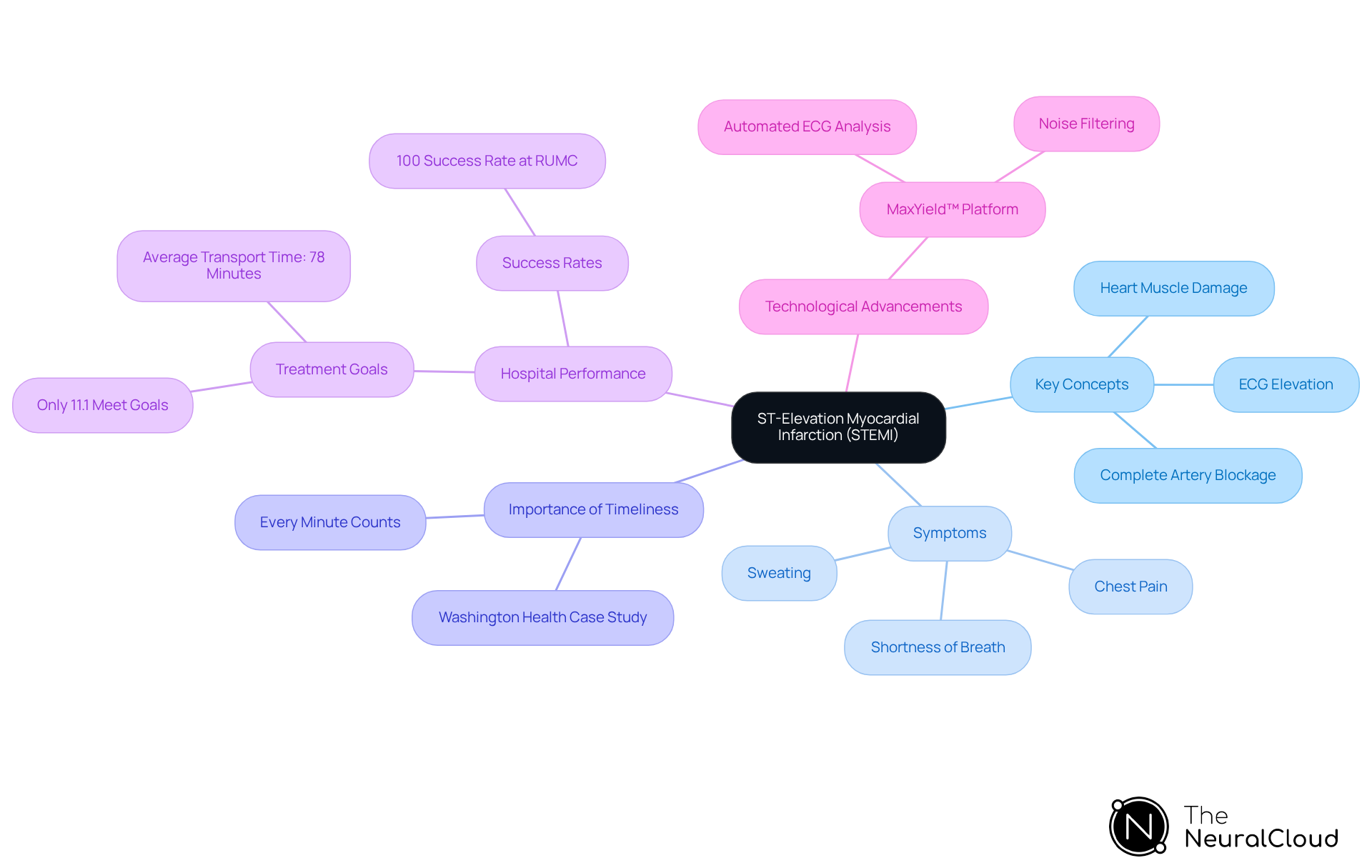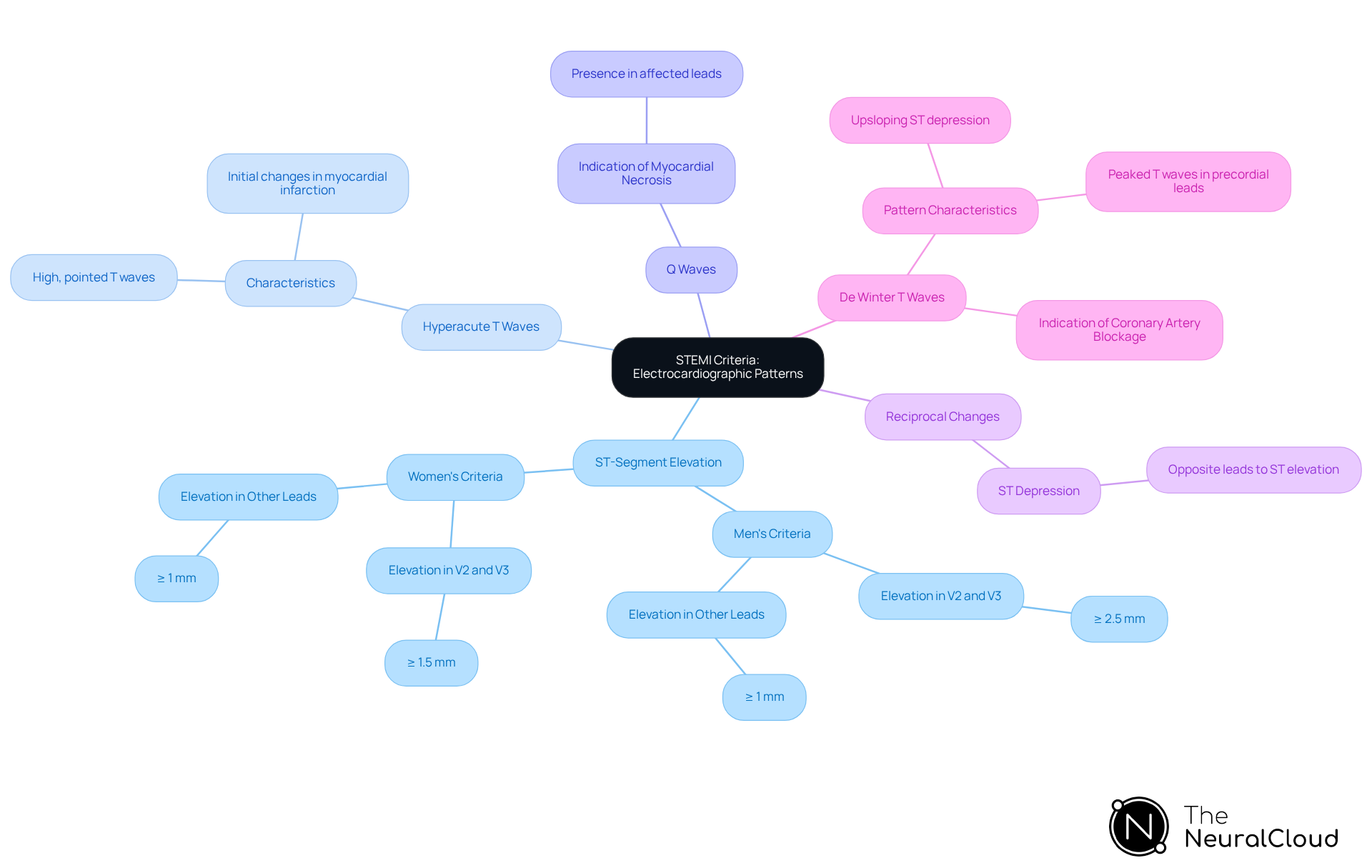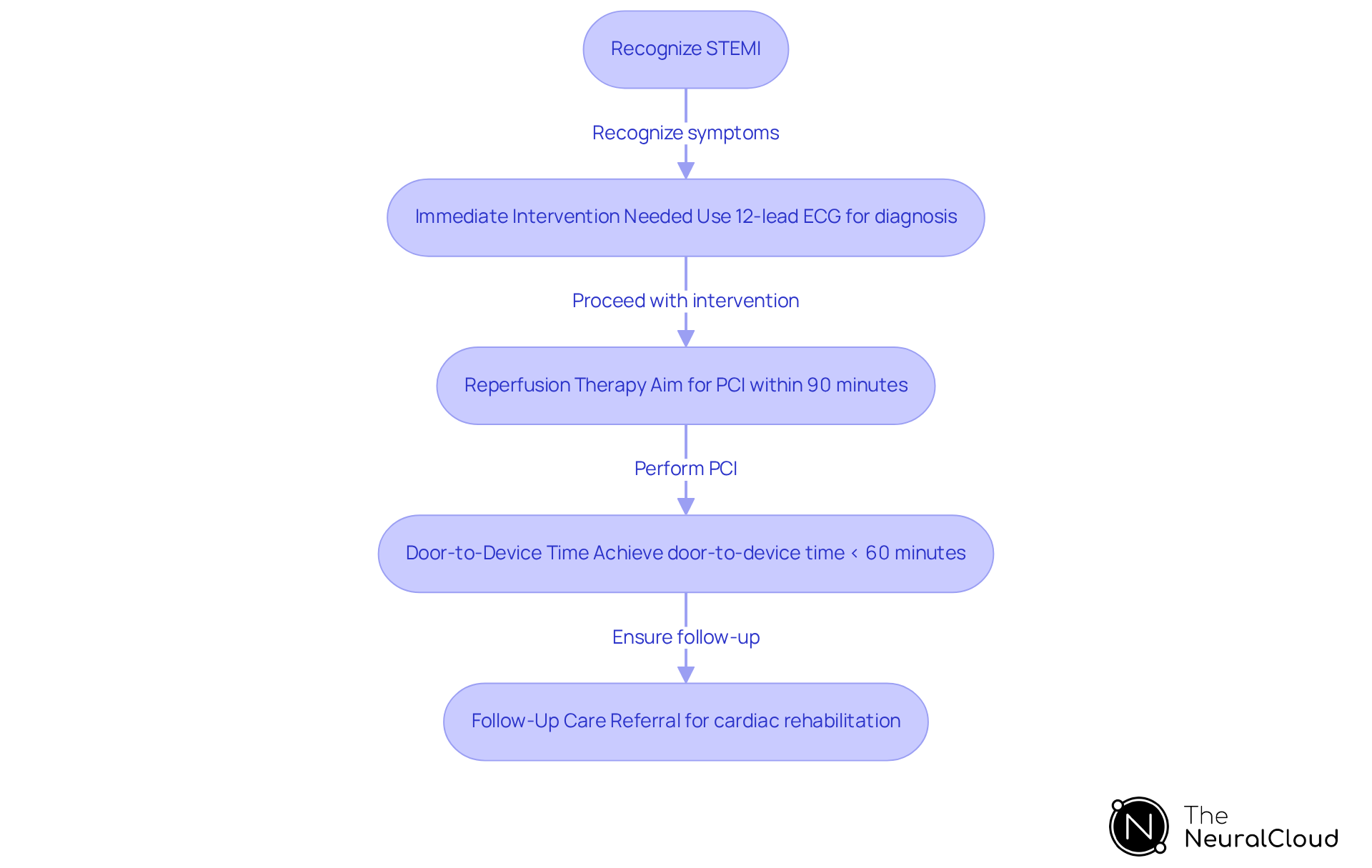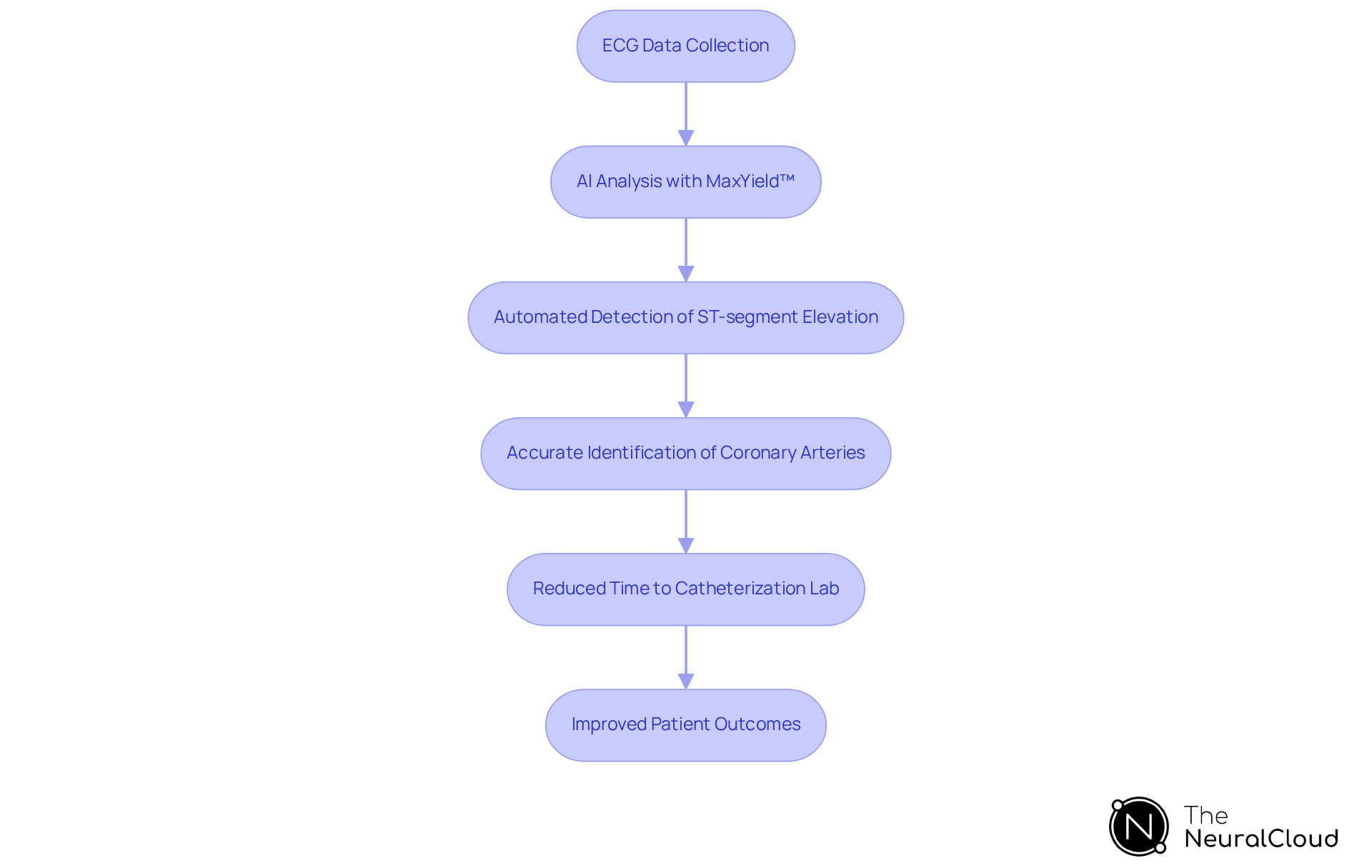Overview
The article provides an overview of essential electrocardiographic patterns for identifying ST-Elevation Myocardial Infarction (STEMI), which is vital for prompt medical intervention. It details specific ECG criteria, including:
- ST-segment elevation
- Hyperacute T waves
Rapid recognition and treatment are emphasized, as they can significantly enhance patient outcomes and minimize the risk of severe complications. This is further supported by advancements in ECG technology that improve diagnostic accuracy.
Introduction
Understanding the intricacies of ST-Elevation Myocardial Infarction (STEMI) is crucial for healthcare professionals, as this condition presents a significant threat to patient health. By exploring the key electrocardiographic patterns that characterize STEMI, practitioners can enhance their diagnostic capabilities and improve patient outcomes.
However, a challenge persists: how can one swiftly and accurately identify these critical ECG changes amidst the noise of everyday clinical practice? This article examines the essential criteria for diagnosing STEMI, the implications of timely intervention, and the impact of advanced technologies on transforming ECG analysis.
Define STEMI: Key Concepts and Importance
ST-Elevation Myocardial Infarction (STEMI) represents a critical type of heart attack, marked by the elevation of the ST segment on an electrocardiogram (ECG). This elevation indicates a complete blockage of a coronary artery, potentially causing significant damage to the heart muscle due to insufficient blood flow. Timely identification of a heart attack using STEMI criteria is vital, as is necessary to restore blood circulation and mitigate heart injury. Common symptoms include chest pain, shortness of breath, and sweating, positioning STEMI as a leading cause of morbidity and mortality worldwide.
Addressing this medical condition is of utmost importance. Research indicates that every minute is crucial when managing heart attacks; delays in treatment can severely affect patient outcomes. For instance, Washington Health has been recognized for its commitment to swift, research-driven treatment for heart attack patients, achieving an impressive 'first contact to balloon time' of 78 minutes, well below the 90-minute standard required for certification. This rapid response has been proven to reduce heart muscle damage, emphasizing the necessity of timely intervention.
Moreover, the American Heart Association highlights that only 11.1% of hospitals meet the recommended treatment goals for heart attack patients, revealing a significant gap in care. Effective recognition and treatment protocols based on STEMI criteria are essential to enhance these statistics and ensure that patients receive the necessary care without unnecessary delays. The integration of advanced technologies, such as Neural Cloud Solutions' MaxYield™ platform, can markedly improve the ECG analysis process. By employing automated labeling and advanced noise filtering, MaxYield™ enables healthcare providers to swiftly identify critical ECG features, even in recordings with high noise levels and artifacts. This capability directly addresses the challenges of prompt recognition and intervention of heart attacks, allowing healthcare providers to respond quickly and efficiently.
As Dr. Francesco Rotatori, Chairman of the Cardiovascular Department, emphasizes, 'Every minute counts when saving heart muscle,' underscoring the profound impact of prompt action on patient outcomes. Additionally, logistical challenges and resource limitations can lead to treatment delays, complicating the care process further. For healthcare professionals, understanding the fundamental principles of myocardial infarction and the urgency associated with it is essential for delivering prompt and effective care.

Identify STEMI Criteria: Electrocardiographic Patterns
The identification of ST elevation myocardial infarction relies heavily on specific electrocardiographic patterns that are critical for timely intervention. Key criteria include:
- ST-Segment Elevation: A defining feature of this condition is the elevation of the ST segment in two or more adjacent leads. For men, this is typically defined as an elevation of 2.5 mm or more in leads V2 and V3, and 1 mm or more in other leads. For women, the thresholds are slightly lower, with 1.5 mm in V2 and V3, and 1 mm in other leads.
- Hyperacute T Waves: These waves signify the initial changes in myocardial infarction with ST elevation, characterized by high, pointed T waves that may appear before ST elevation.
- Q Waves: As the infarction advances, Q waves may emerge, indicating myocardial necrosis. The presence of Q waves in leads corresponding to the affected area can confirm the diagnosis.
- Reciprocal Changes: ST depression in leads opposite those exhibiting ST elevation can further support the diagnosis of myocardial infarction.
- De Winter T Waves: This pattern, characterized by upsloping ST depression with peaked T waves in the precordial leads, is considered a myocardial infarction equivalent and indicates significant coronary artery blockage.
Recognizing these patterns on an ECG is essential for healthcare professionals, as prompt identification can greatly influence patient outcomes. Current guidelines emphasize the importance of the stemi criteria in diagnosing this condition, aligning with the American Heart Association's recommendations for effective treatment protocols. With each year, the need for accurate and swift diagnosis is vital to prevent substantial cardiac injury.
The MaxYield™ platform enhances ECG analysis by automating the process, reducing noise, and providing beat-by-beat analysis of 200,000 heartbeats in under 5 minutes. This capability significantly improves the identification of critical patterns. Additionally, MaxYield™ can recover previously obscured sections of recordings, ultimately aiding in better clinical decision-making and enhancing patient care.

Understand the Clinical Implications of STEMI
The clinical implications of [ST elevation myocardial infarction](https://theneuralcloud.com/post/stemi-medical-abbreviation-definition-and-clinical-importance) are significant, as this condition can lead to severe morbidity and mortality if not addressed promptly. Immediate recognition and intervention are essential for restoring blood flow to the affected myocardial tissue, thereby preventing irreversible damage. Delayed treatment can result in serious complications, including heart failure, arrhythmias, and sudden cardiac death. Statistics indicate that approximately 285,000 people in the U.S. suffer a heart attack annually, underscoring the need for effective management.
A coordinated strategy among healthcare professionals—including emergency medical services, cardiologists, and nursing staff—is vital to ensure that individuals receive prompt reperfusion therapy, such as percutaneous coronary intervention (PCI) or thrombolysis. Heart attack receiving centers should strive for arrival-to-PCI times within 90 minutes, with many institutions achieving door-to-device times of less than 60 minutes. This level of efficiency is crucial, as research suggests that prompt intervention significantly enhances outcomes for individuals, reducing the risk of complications.
Case studies, such as the Mission: Lifeline program, demonstrate that establishing organized care systems can improve the timely treatment of individuals experiencing heart attacks, resulting in enhanced survival rates. Additionally, cardiologists emphasize the importance of prompt intervention, stating that the initial diagnostic assessment for individuals experiencing chest pain should involve a 12-lead ECG, which is essential for accurate detection. The advanced noise filtering and wave recognition capabilities of MaxYield™ help ensure that these ECGs are as clear and accurate as possible, facilitating quicker and more reliable diagnoses.
Furthermore, the challenges faced by rural communities in obtaining prompt treatment for heart attacks must be acknowledged, as these obstacles can significantly impact health outcomes. MaxYield™ addresses these issues by transforming lengthy and noisy ECG recordings into clear, actionable data, enabling healthcare professionals to analyze more information in less time. Understanding these clinical implications allows healthcare professionals to effectively prioritize heart attack cases by applying the and implement strategies that improve patient outcomes, ultimately saving lives.

Explore the Role of Advanced ECG Technologies
Advanced ECG technologies, particularly those developed by Neural Cloud Solutions, significantly enhance the precision and effectiveness of heart attack diagnosis. By integrating AI and machine learning algorithms into ECG analysis, these technologies facilitate automated detection of ST-segment elevation and other critical patterns associated with stemi criteria. The MaxYield™ platform excels in identifying and labeling essential data, even in recordings with high levels of noise and artifact. This capability allows for the rapid isolation of ECG waves from challenging recordings. Studies indicate that AI algorithms can achieve an accuracy of 90.9% in identifying occluded coronary arteries, closely matching expert ECG readers. Such accuracy enables the swift processing of large volumes of ECG data, providing healthcare professionals with real-time insights that support timely decision-making.
The implementation of AI-driven ECG systems, such as MaxYield™, has shown a reduction in the time from ECG to catheterization lab entry. The ARISE study reported a decrease from 52 minutes to 43 minutes, underscoring the efficiency of these advancements. These improvements not only minimize the risk of human error but also empower clinicians to concentrate on patient care, ultimately enhancing overall outcomes. Moreover, the continuous learning model of MaxYield™ improves ECG analysis accuracy and efficiency, allowing for better classification of patients into high- and low-risk subgroups, which leads to improved treatment outcomes.
As the field of cardiology continues to evolve, adopting these innovative technologies will be crucial for optimizing STEMI management according to the stemi criteria and enhancing diagnostic precision. This ensures that healthcare providers can respond effectively to acute cardiac events, ultimately .

Conclusion
Understanding ST-Elevation Myocardial Infarction (STEMI) is crucial for timely and effective cardiac care. This article highlights the importance of recognizing specific electrocardiographic patterns that define STEMI, underscoring the need for swift medical intervention to minimize heart damage. Every moment counts in the management of heart attacks, reinforcing the necessity for healthcare professionals to be well-versed in the criteria and technologies that facilitate rapid diagnosis and treatment.
Key insights include critical electrocardiographic patterns associated with STEMI, such as:
- ST-segment elevation
- Hyperacute T waves
- Reciprocal changes
The MaxYield™ platform enhances ECG analysis by improving accuracy and efficiency. This integration allows healthcare providers to make informed decisions quickly, ultimately benefiting patient outcomes. Furthermore, organized care systems significantly improve outcomes for heart attack patients, particularly in emergency settings.
In light of staggering statistics surrounding heart attacks, the call to action is clear: healthcare professionals must prioritize understanding STEMI criteria and leverage innovative technologies to enhance patient care. Timely interventions can save lives and reduce the long-term consequences of myocardial infarction. The ongoing evolution in cardiology, driven by advancements in ECG technology, promises a future where rapid and accurate diagnosis becomes the standard, significantly improving outcomes for individuals experiencing this critical condition.
Frequently Asked Questions
What is STEMI?
ST-Elevation Myocardial Infarction (STEMI) is a critical type of heart attack characterized by the elevation of the ST segment on an electrocardiogram (ECG), indicating a complete blockage of a coronary artery and insufficient blood flow to the heart muscle.
Why is timely identification of STEMI important?
Timely identification is crucial because immediate medical intervention is necessary to restore blood circulation and minimize damage to the heart muscle. Delays in treatment can severely affect patient outcomes.
What are the common symptoms of STEMI?
Common symptoms of STEMI include chest pain, shortness of breath, and sweating.
How does Washington Health demonstrate effective treatment for STEMI?
Washington Health has achieved a 'first contact to balloon time' of 78 minutes, which is below the 90-minute standard required for certification, showcasing their commitment to swift, research-driven treatment for heart attack patients.
What is the significance of the American Heart Association's findings regarding hospital treatment for heart attacks?
The American Heart Association reports that only 11.1% of hospitals meet the recommended treatment goals for heart attack patients, highlighting a significant gap in care that needs to be addressed.
How can advanced technologies improve the recognition of STEMI?
Technologies like Neural Cloud Solutions' MaxYield™ platform enhance ECG analysis by employing automated labeling and advanced noise filtering, allowing healthcare providers to quickly identify critical ECG features even in challenging recordings.
What does Dr. Francesco Rotatori emphasize about treating heart attacks?
Dr. Francesco Rotatori emphasizes that 'Every minute counts when saving heart muscle,' highlighting the importance of prompt action for better patient outcomes.
What challenges do healthcare professionals face in treating STEMI?
Logistical challenges and resource limitations can lead to treatment delays, complicating the care process for patients experiencing a heart attack.






